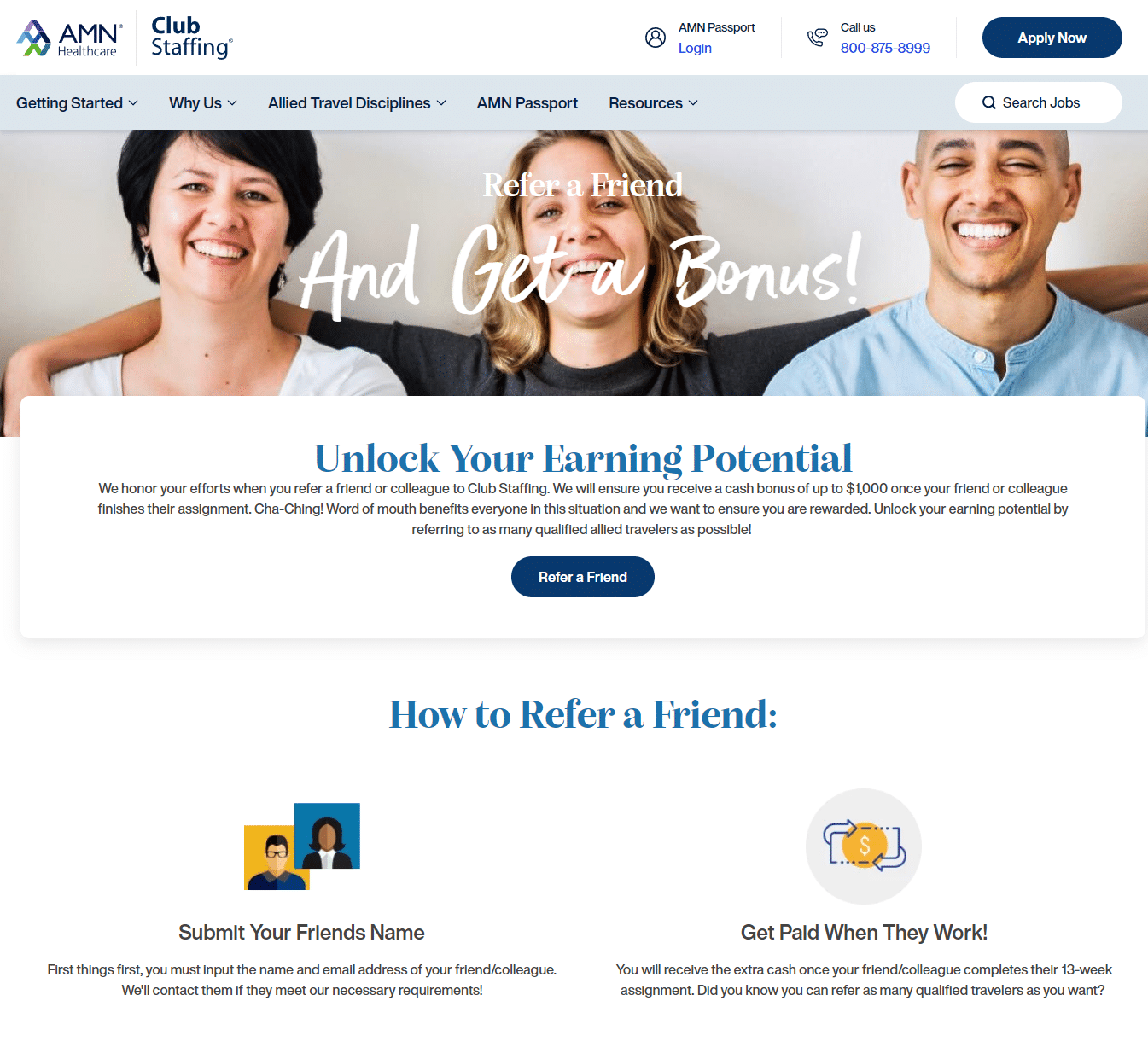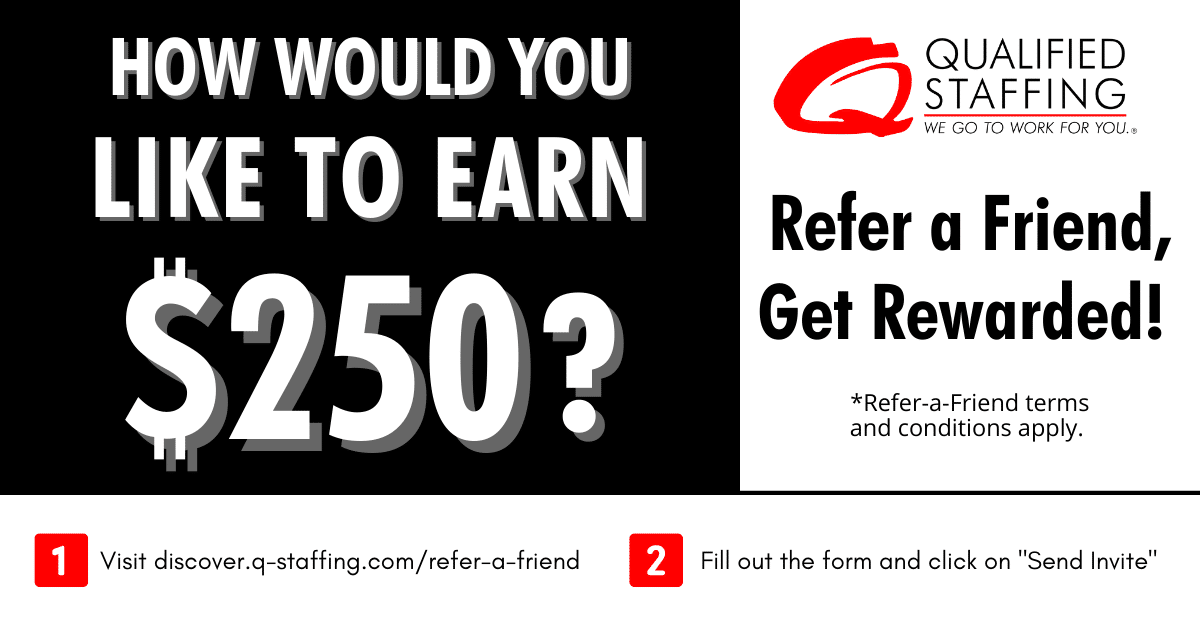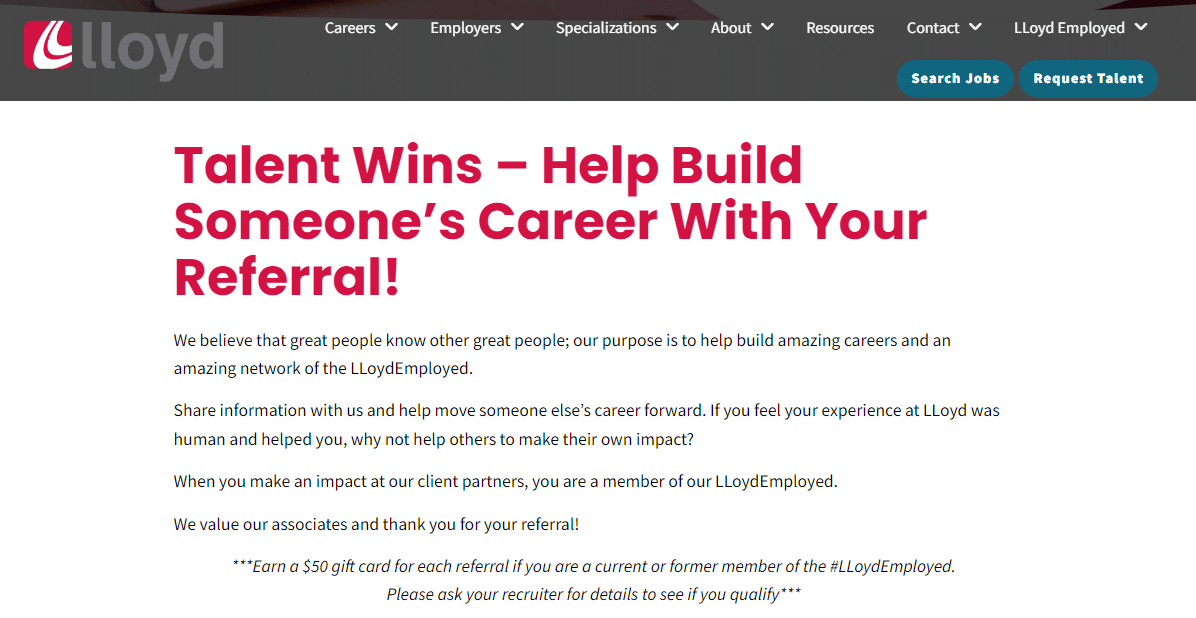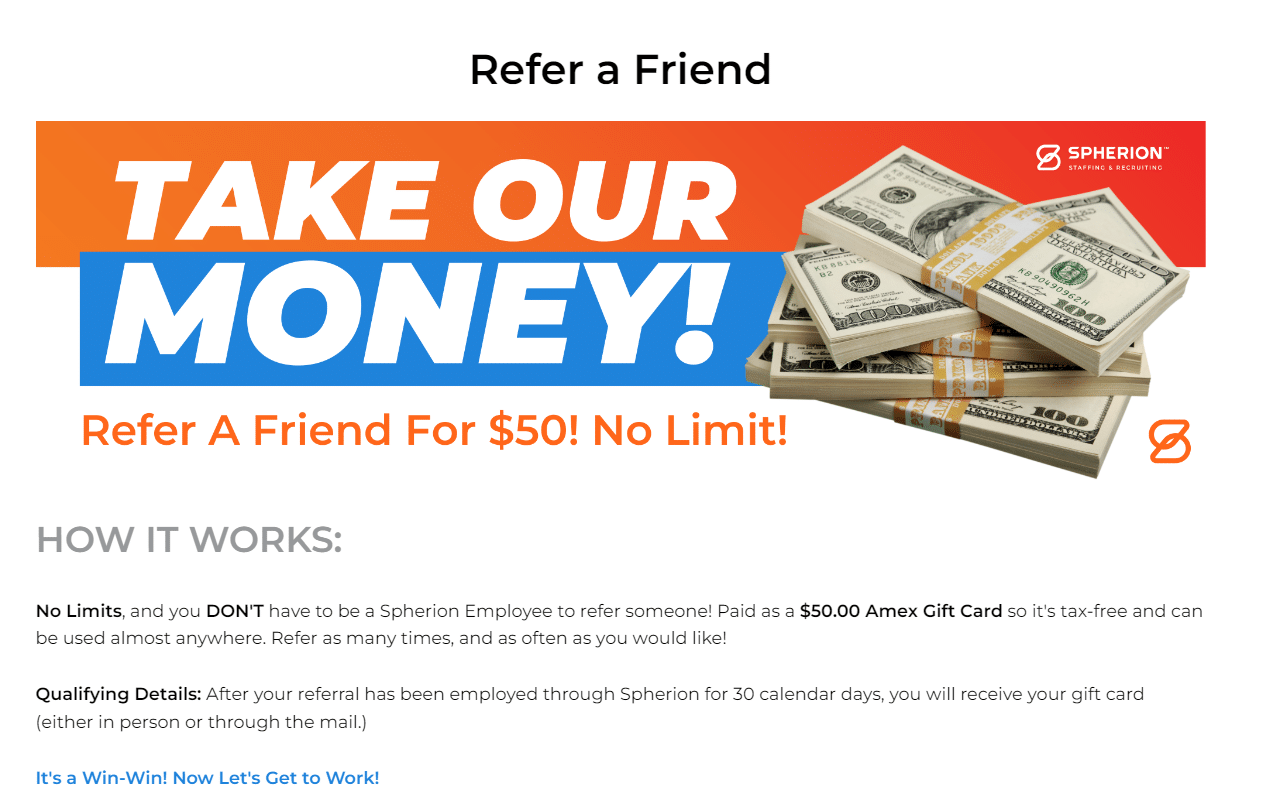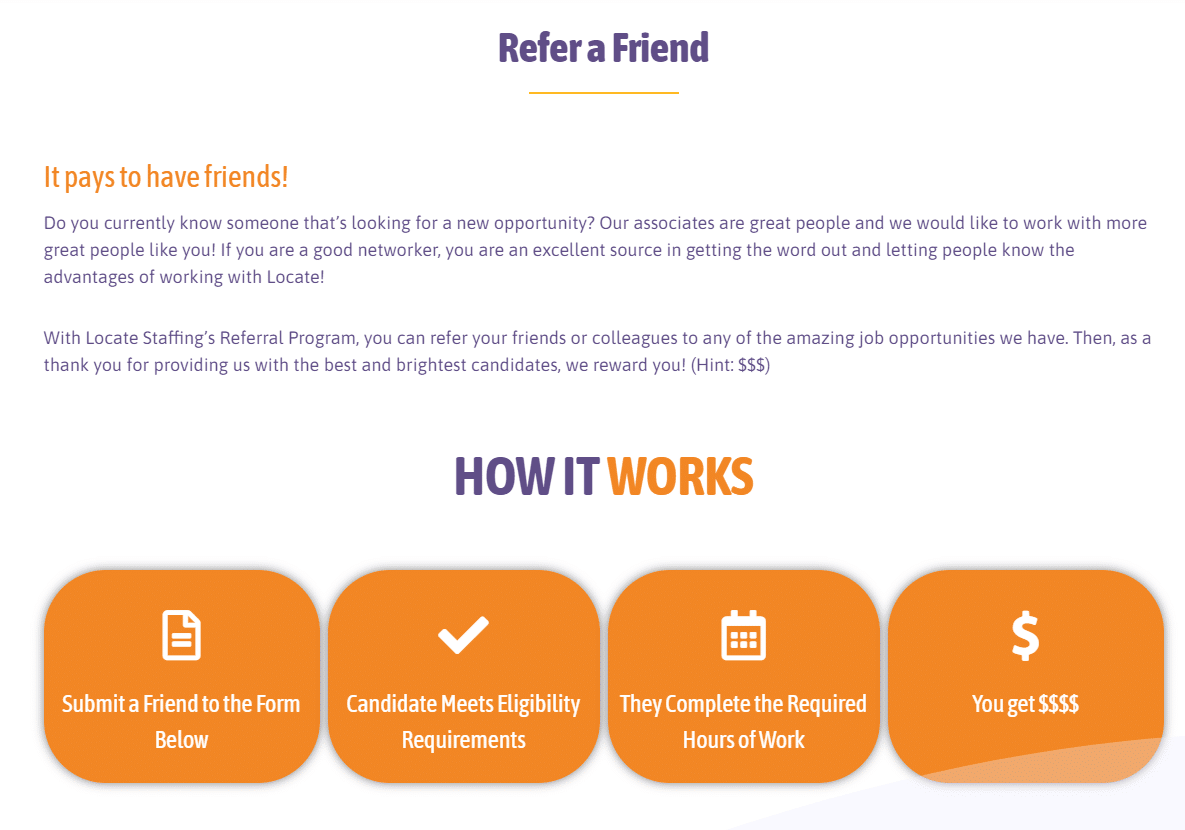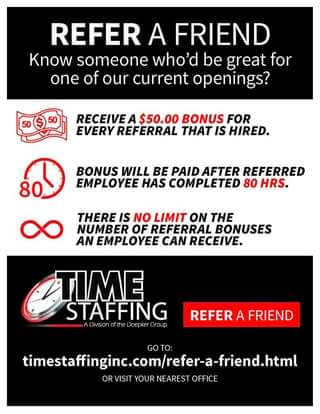If you’re looking for a low-cost but highly effective way to promote your staffing agency, consider implementing a staffing agency referral program. It’s a type of referral program where you incentivize people for referring other businesses to you who would benefit from your services – or quality candidates who can fill up the roles you’re advertising. Sometimes you’ll also hear the program simply referred to as a referral bonus program.
All parties involved in this form of referral program are set to gain in some form or the other.
- Businesses can take advantage of your recruitment services and tap into your talent pool of qualified candidates.
- Candidates have access to matching job vacancies or best-fit open positions.
- Anyone who successfully refers businesses and/or candidates gets rewards.
- You get increased exposure and more profit over time for your business.
In this article, we will cover the following:
- What is a staffing referral program?
- The two types of staffing referral programs
- Staffing referral programs vs. employee referral programs
- Why should you start a staffing referral program?
- Staffing referral program best practices
What is a staffing referral program?
A staffing referral program is a type of referral program that rewards people for bringing in successful referrals. Successful referrals take place when a client signs up for your staffing services, or a referred candidate gets hired by one of your client companies. The rewards act as incentives to promote frequent sharing and encourage momentum.
You can also use a staffing referral program to track who’s sending you referrals, so you can identify new avenues of growth.
Two types of staffing referral programs
When we talk about staffing referral programs, two types exist:
1. People refer other businesses who might benefit from your staffing agency’s recruitment services: When a referral successfully brings in a new business, both entities (i.e., the new client as well as the referring party, which could be a person or a business) are eligible for payouts. Since it’s a business getting referred, this type of program functions very much like a B2B referral program.
2. People refer qualified candidates for job openings your staffing agency is looking to fill: A referred candidate signs on with the agency, but the referring person isn’t eligible for rewards straight away. Instead, the eligibility kicks in only when the referred candidate goes through a formal interview process with the agency’s client and/or gets hired.
Staffing referral program vs. employee referral program
At the outset, a staffing referral program and an employee referral program can look very similar. They serve the same goal in the sense of expanding your client base and talent pool, and rewarding referrers in the process. But both are different in the type of people deployed to send the referrals.
- In an employee referral program, a business asks their current employees to refer candidates to fill job positions. You can even ask your employees to bring in new leads who may potentially want your specific products or services.
- In a staffing referral program, you’re asking for referrals of new clients who may need your staffing agency’s recruitment services, or candidates who may successfully fill the job openings your client companies have. But your customers – not employees – will do the referring in a staffing referral program.
Why should you start a staffing referral program?
The staffing industry can be notoriously competitive. Implementing a staffing referral program as part of your marketing activities can be beneficial to helping you stand out. While it’s a great strategy on its own, you should ideally combine it with your standard marketing stack of paid and organic promotional methods for the best results.
Benefits of any staffing referral program
Creating and running a staffing referral program provides many benefits for both new business and quality candidate acquisition.
A staffing referral program has a lower client acquisition cost, compared to other marketing methods used to promote your agency. After all, much of the marketing legwork is done by referrers themselves in terms of sharing and promotion. The more they promote your agency, the more likely they’ll get successful business leads or new hires.
Staffing referral programs are also low risk to use. You only pay for the software and when referrals return results. So, you aren’t spending blindly like with other marketing methods.
And most importantly, using a formal referral program helps you track sources of new business or candidate leads. For example, are email promotions or social media channels (like LinkedIn, Facebook, etc.) more effective at engaging referrers and bringing in new leads?
Also, finding people who are great at bringing in new business or candidates, partnering up with them, and providing exclusive benefits for increased returns would make business sense. If you’re using software, it makes it that much easier to track and reward referrers, and figure out who are your top advocates.
Benefits of a staffing referral program for business referrals
A staffing referral program can help increase awareness of the existence of your agency, and what’s on offer when clients sign up. Referral schemes that offer bonuses are more likely to be shared, given that the referrers could potentially get a reward. This can mean that you reach a much wider audience within the industries you serve.
It’s also great for bringing in clients who are more likely to convert to customers. It’s been proven through research that people generally trust peer recommendations over direct brand advertising, which can appear less genuine and authentic. Your referrers function like organic brand ambassadors. Besides, referred clients are more likely than unreferred clients to stay with your business for longer.
Benefits of a staffing referral program for candidate referrals
A staffing referral program can be just as effective for candidate referrals for the same reasons.
Referred employees (AKA potential candidates who get hired) are more likely to move through the hiring process because someone they trust has referred your agency to them. Referred candidates are more likely to accept jobs because they trust the person who referred them, and more likely to fit well in positions, since referrers know their reward hinges on finding good-fit hires.
Referred candidates tend to be higher-quality hires, who generally have higher retention rates. Also, just like for client referrals, a staffing referral program is low-risk and low-cost compared to traditional marketing methods, and lets you harness word of mouth in a trackable way.
Staffing referral program best practices
When you create a staffing referral program, make sure you check off the following list of best practices, so you don’t miss out on any relevant aspect of building a successful referral program:
1. Set SMART goals
There’s a reason why SMART goal-setting is still relevant – it works. When your goals are set using the SMART framework, you can achieve your targets over time, provided you stick to the framework till the end.
The acronym SMART, which stands for Specific, Measurable, Achievable, Realistic, and Timely, is a more strategic method of defining and refining your goals to increase your chances of achieving them. SMART goals help you get clarity, focus your activities, and use your time and resources productively.
Make your goals as specific and narrowly defined as possible. Ask yourself what you want to achieve, why it’s essential, and the results you expect from achieving these goals in a given timeframe. Goals like “Increasing your client base” or “reducing time-to-hire” can be vague. Try reframing goal statements in the form, “increasing client base by X%” or “reducing time-to-hire by Y%” to get “Z results.”
When you think about the numbers, also think about how you will achieve the numbers and how you can work through potential challenges that can come up.
When drafting SMART goals, it’s also critical that they’re achievable and realistic .Start small with your goal-setting to avoid disappointment. Make sure that your goals are achievable within the time frame you’ve set, with the knowledge, resources, and support you have.
2. Use software to track your referrals
Your agency needs to set and track progress towards measurable goals to see if the referral program is returning the desired results. And it’s vital to know who makes successful referrals, so you can issue rewards in a timely manner.
It’s nearly impossible for a staffing agency to do this manually — you need referral software as your program’s foundation.
- Metrics are key to understanding your ROI. Using referral software can help you collect the kind of detailed analytics required by your agency to understand what you’re doing right and where you’re going wrong. Real-time, accurate data is essential to refining your marketing strategies for optimal results.
- In the absence of referral software, it’s challenging to identify the source of referred leads and candidates.
- Plus, software will automatically credit rewards where they are due in a timely manner.
If you’re trying to find new business clients for your staffing agency, make sure you use referral software that’s made with the specific needs of B2B users in mind. Not all referral software is equipped for this purpose. And if you’re looking for candidate referrals, you’ll need software built for employee referral programs – employee referral software.
Referral Rock is referral software that’s advanced enough to run both B2B referral programs (with multi-step rewards) and employee referral programs. You can even run both at the same time!
3. Make sure recruiters are on board
Bring your key stakeholders from the hiring team, such as recruiters and hiring managers, into the loop. They may not traditionally comprise the sales cycle. However, they are just as important for buy-in and client communications.
Recruiters should know all about the program and how to tell your clients about it. They should understand how referrals will help out your current and future business clients (as well as people looking for new jobs). In fact, your recruitment team should be just as vested in the program as you are, and able to confidently discuss all the relevant aspects if clients ask them about it.
Be sure to:
- Walk your recruitment team through the program during informational sessions.
- Discuss the benefits of such a program both from the client’s and the candidate’s perspective.
- Walk them through the fundamentals of how to use the software.
- Also, walk them through the process of referral tracking and how they can promote and share referral links.
Lastly, engage recruiters and hiring managers by showcasing the benefits of using automated referral software. Discuss how it can help make them more time-efficient and productive at their jobs – when referrals are automated, this will let them focus on the candidate experience and client experience more closely.
4. Offer meaningful rewards
When you’re creating your rewards scheme, think of creating meaningful rewards. Your agency should be able to afford these payouts. At the same time, they should be high enough to motivate referrals.
Reward referrers right away for successful client signups or candidate hires. For client signups, success can mean different things for different staffing agencies. You can either payout when the client is qualified or after they’ve settled their first payment. For candidates, provide payouts once the candidate has passed a formal interview with a client agency and accepts the job offer.
Cash rewards are often the best call as an agency referral reward, especially if you’re running a candidate referral program. But if you’re looking for B2B referrals, you may want to tailor your approach.
For B2B referrals, reward both the existing clients and the clients they’ve referred to you. It’s a great way to keep the referral cycle going. Consider rewarding both existing and new clients with discounts on your services, to encourage client retention on both sides.
But you could also explore other attractive reward options such as:
- Sales and marketing funds
- Charitable donations
- Gift cards or baskets
- Subscriptions to work-friendly tools
- Tangible items someone could use at work
- Professional development opportunities
Instead of using a linear rewards model, consider a multi-step rewards structure. That’s when you reward your referrers at different stages of the referral process.
- So, for a client, you can look at rewarding when the lead is qualified, and rewarding again when the client makes the first payment.
- For candidates, you can reward when a candidate applies for a job, share a bigger reward when the candidate gets an interview call, and share the biggest reward for when the candidate gets hired.
You can also leverage subscription services for your rewards scheme. Since agency services are generally recurring, you could provide bonuses to the referrer if the client signs up for a subscription, say an annual subscription.
5. Make sharing easy
The next step is to make sharing as easy as possible for your referrers. If sharing your program is cumbersome, it’s unlikely you will get any actual shares. Whether it’s on your email, your program landing page, or a Facebook post, follow the best practices outlined below:
- Make your program easy to find on your website, through plenty of promotion.
- Discuss how the program actually works, but make the description concise and readable. Ideally, limit your info to about three to four steps.
- Talk about the rewards. What are they, how will they be earned, and when will the clients get credited?
- Ideally, provide clickable and shareable referral links that are easy to copy and paste anywhere.
- Provide multiple sharing options such as social media, email, and text.
- Make sure your program is mobile-responsive, as that’s where your clients mostly are.
- In terms of the sharing process itself, make sure it can be completed in as little as a few clicks or taps.
6. Use your referral program page to motivate sharing
The last thing you want to do is skimp on the design and copy for your staffing referral program page — the place where you showcase what your program is all about.
- Use an attention-grabbing headline right in the beginning that encourages further reading and page-sharing.
- Highlight the incentives and benefits of your referral program, not just the features.
- Keep content short, concise, and readable.
- Lastly, create a clear call-to-action (CTA) that’s simply hard to resist.
Read our guide 5 Must-Haves for Mastering Your Referral Program Landing Page, which goes into more detail on how to make a high-converting landing page.
7. Create personalized, strategic referral messages
Another focus area for your staffing referral program should be making your marketing messages personalized and strategic. We’re specifically referring to the messages that your referrers will be sending out to source clients and leads.
You can share message templates that referrers can personalize and customize for their recipients. At the same time, share the core information about the program so that your referrers don’t have to create the material from the ground up. Include what the program is about and how it works.
Ensure the message is optimized for the media channel and the type of referral that’s being sourced.
- For candidate referral messages, the content should include information about the job and your agency.
- For business referral messages, the content should include a brief about your agency and the benefits of working with you.
If you’re running a hiring referral program, make sure there are follow-ups for candidates, to check in about interviews or other aspects of the hiring process.
8. Promote your program on a variety of channels
Execute a consistent promotional strategy, so your agency is top of mind for client and candidate referrers.
- Share regular posts about your staffing referral program on all your social media accounts.
- Ensure you have a full-fledged staffing referral program landing page that you can direct traffic to.
- Include a referral section in your agency portal, so clients can find it when they log in.
- Place “refer a friend” CTA buttons in visible locations across website headers and footers.
- Display banners and signage in staffing offices.
- Send mass program promotional emails and newsletters. They might lack the personalization, but they’re still useful to promote your program.
- Send personal and exclusive invitations to top clients, say, clients who have used your services for more than a few years.
- Mention the program, or share the refer-a-friend CTA, in transactional emails (such as sign-up confirmations or payment invoices).
- Add a link to your program in all the email signatures of your team members.
- Direct clients to the program after they have given high ratings on a client satisfaction survey. They’ll be more likely to refer you when they’re in that state of heightened gratification.
9. Thank clients for referrals
There isn’t a person in the world who doesn’t enjoy being appreciated. Timely appreciation encourages relationship-building and motivates the recipient to want to do more. Extend the same level of appreciation to your referrers.
This goes beyond just sending rewards whenever referrals are successful. You can go the extra mile by sending out personalized, hand-written thank you notes whenever referrals start inquiries or candidates sign up. You could even spotlight referrers publicly, on your website, blog, or social account, as another way to say thanks.
10. Track and measure your success
Tracking your program metrics helps you make sure your program is a success and gives you
insights if anything isn’t performing to the level you expect. This intelligence can be invaluable in determining how to optimize the ROI for your marketing activities.
Essential metrics that all staffing agencies should look at in their referral programs are:
- The number of referrals you’re receiving over set periods
- The percentage of current clients who proceed to making referrals
Staffing agencies running business referral programs should check:
- The percentage of referred businesses that eventually convert to clients
- The retention rate of referred clients vs. all your clients
- The lifetime value (LTV) of referred clients vs. all your clients
Staffing agencies running candidate referral programs should check:
- The percentage of referred candidates who apply for jobs, get accepted for interviews and get hired.
11. Use other referral program best practices
Some of the best practices for your staffing referral program can be successfully borrowed from B2B referral programs for client acquisition, and employee-to-employee referral programs for candidate acquisition.
Here are a few of our in-depth resources you can leverage for ideas on both:
- How to Build a B2B Referral Program [The Ultimate Guide]
- Employee Referral Programs: How to Bring in Top Talent and Sign Up–Ready Clients
- Case Study: How Catapult Generated 4500+ Referrals in 6 Months with Referral Rock
A staffing referral program is a great way to expand your client base, increase your talent pool, and generate awareness of who you are and what you do. Follow the tips shared in this article to maximize the chances of making your program a success.

